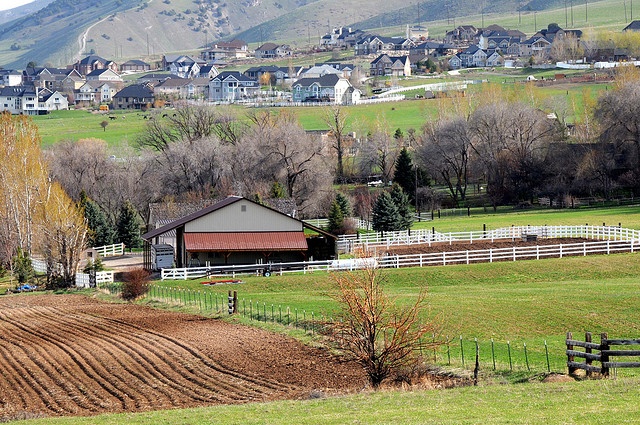Farming by the Numbers: The Greenbelt Tax and Cache economics
December 16th, 2015 Posted in OpinionBy Jordan Floyd
LOGAN — With the passing of Nov. 30 — Cache County’s due date for property taxes — many are left to mull over a seemingly endless and worrisome tax-day qualm: “Where does my money go?”
The question is understandable.
 According to a 2015 op-ed column by Manhattan Institute fellow Jared Meyer, Americans paid $4.8 trillion in taxes in 2014-2015, and spent “30 percent of the year working to pay the government.”
According to a 2015 op-ed column by Manhattan Institute fellow Jared Meyer, Americans paid $4.8 trillion in taxes in 2014-2015, and spent “30 percent of the year working to pay the government.”
Locally, Cache County reports that residents paid $45,915,697 in taxes in 2014. Of this amount, $15,653,023 came from property taxes, the county’s largest source of revenue, $4 million more than the next largest source, sales tax.
Most Cache County taxpayers may not know, however, that roughly one-third of the land in the county is taxed at a fraction of the amount assessed to the remaining two-thirds.
Agricultural land falls under special provisions of the Greenbelt Act, which aims to preserve agricultural land in the state. Adopted by the Utah Legislature in 1969, the law taxes land that is actively farmed at a substantially lower rate than residential and commercial property.
In 2015, Cache County had 7,600 parcels of land that benefited from the Greenbelt Act, says Cache County Assessor Kathleen Howell. She estimates the parcels carried a collective market value of $1,156,728,571, but were only taxed on $47,981,905 (4 percent of the land’s market value). The county collected roughly $575,000 from landowners who benefitted from the Greenbelt Act – essentially giving a 96 percent discount to agricultural landowners.
On the surface, the Greenbelt Act may look like a drastic exemption that deprives the county of revenue used for things such as public schools, which arouses an additional tax-day qualm: “Is it fair that some residents pay less in taxes than others?”
Economic Pressures on Farmers
To those in the Cache County agricultural community, the exemption is vital to economic survival.
“The intent of the Greenbelt tax is to enable farmers to continue to farm profitably as surrounding land prices continue to increase,” said Cache County Executive Craig Buttars. “This is particularly relevant in areas surrounding our growing cities.”
 The Cache Valley is a burgeoning area whose population grew 23 percent from 2000 to 2010, according to the U.S. Census Bureau. A rising population means increased development, which puts pressure on farmers who may choose — or be forced by economic pressures — to cash in by selling their farmland to developers.
The Cache Valley is a burgeoning area whose population grew 23 percent from 2000 to 2010, according to the U.S. Census Bureau. A rising population means increased development, which puts pressure on farmers who may choose — or be forced by economic pressures — to cash in by selling their farmland to developers.
Losing farmland damages the Cache Valley community, says Clark Israelsen, the Cache County Extension Agricultural Agent. “Cache County agriculturists generate more than $170 million annually in new products at the farm gate,” Israelsen said. “That dollar amount is multiplied as it moves through the system. That agricultural contribution far exceeds the total value of taxes that would be collected without Greenbelt.”
Additionally, agricultural operations are inherently expensive. Total taxes and operations and maintenance costs largely negate the money farmers save through the Greenbelt Act, Israelsen said.
“Owners of agricultural lands actually pay more total taxes than they require for services,” Israelsen said. “That’s not necessarily the case with residential or industrial properties — that’s why the Utah State Legislature wisely allows for a modification of taxation on productive agricultural lands.”
Utah State University’s Cooperative Extension Service released a study in 2012 that outlined the costs and returns of agricultural production in Cache Valley. The report found that for someone wanting to establish an agricultural operation producing just alfalfa hay on 150 acres, the total first-year operation, overhead and ownership costs were $93,963.18. Subtract the projected first-year earnings from the total establishment costs, and the net cost to establish an agriculture operation was just below $19,000.
In the second year, the study found, costs would be $83,505.81, with a profit of $10,000.
If the projections by the department are correct, it could take two years for an agricultural operation to overcome initial establishment costs and make a profit.
Greenbelt Beauty
But Buttars believes the benefits of the Greenbelt Act extend beyond economic. Farmland conservation contributes to the valley’s aesthetic and feel — it’s something money can’t buy.
“One of the things I hear most from people who visit the valley and those who move here from other areas is their love of the open spaces and the well-tended farms,” Buttars said. “As a farm owner myself, I know how critical the Greenbelt exemption is to preserving agriculture in our county.”
A 2012 USDA Economic Research Service report shows that agricultural production is relatively low in desert Utah compared to other states, although what is produced is beneficial to the economic climate in Cache Valley, Israelsen says.
Here lies the answer to the tax-day qualms.
Farming is a difficult trade that faces unique economic challenges. According a 2009 report by the USU Cooperative Extension Service, “If agricultural property were taxed at market value, farming would be economically prohibitive for most producers because property taxes would increase several fold.”
Going further, Israelsen says that policies like the Greenbelt Act support both the agricultural community and those surrounding it, and without such policies, “farms would simply cease to exist.”
TP
Tags: agriculture, Brent Israelsen, Cooperative Extension Service, Craig Buttars, farming, Greenbelt Act, Kathleen Howell, property taxes

Sorry, comments for this entry are closed at this time.